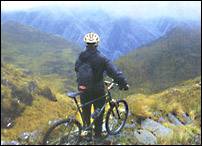Adventure Travel vs. Ecotourism
Before he was an ecotour operator, Bill Mueller took his first trip to Lake Baikal in southern Siberia to participate in a study examining the lake’s fragile ecosystem and the impact of humans. Caught up in one of those enlightening sunset moments, beyond the grasp of any travel brochure, he turned to his trip companions and said, “We must be out of our minds to encourage tourism here.”

Crazy seemed the right word for inviting humans to tromp around in a delicately balanced—and breathtaking—environment. “We felt very protective of that beauty,” Mueller says. “But on the other hand, you don’t want to play God. Otherwise, it’ll be a nice place for a few privileged individuals, and you keep the rest of the world out. So that’s been our dilemma. We wrestle with that.”
The trick, then, to letting the rest of the world in is not by swinging the Range Rover doors wide open, but rather by gradually letting in a trickle of carefully-guided treaders, whose trip dollars ultimately benefit the local nature and culture. This, in theory, is ecotourism, the buzzword for environmentally-friendly travel. But in practice it can be something else.
Eco vs. Ego
One of the largest discrepancies in the travel industry is the confusion between ecotourism and adventure travel. While the terms are often used synonymously, their goals and impacts can be very different. “Ecotourism is altruistic,” says Mueller, who is president of R.E.I. Tours, based in Cedar Rapids, Iowa. “Adventure travel insulates you from the local environment and then utilizes its resources. Unfortunately, there’s a blur between the two.”
This blur is compounded by adventure travel’s rise in popularity. “You don’t hear the word ecotourism as much any more,” says David Anderson, president of David Anderson Safaris, based in Santa Barbara, California and a specialist in African safaris. “It’s either old hat or everyone expects adventure tourism and ecotravel to be the same thing,” he says.
Many outfitters use the “eco” label, whether they truly run green trips or not. Besides, as Anderson points out, being eco-friendly is not an exact science. “There are many out there who believe they are doing the right things, but they may be overlooking some essentials,” says Tom Grasse, vice president of marketing for Alabama’s International Expeditions.
It’s a given that all travel will have some negative environmental impact, including pollution, habitat disruption and resource depletion. The challenge is to minimize that impact, which is one of ecotravel’s ultimate goals, while providing economic incentives to local people and businesses.
Obviously, the softer the trip, the lighter the impact on the physical environment. But for more permanent preservation to be the next level, the ecotourism industry must go a step further with economics. “Many nations are finding out that there’s substantially more money in preserving wildlife and other sensitive habitats,” says Mark Campbell, director of marketing for Mountain Travel-Sobek, based in El Cerrito, California. “People are going to be willing to pay money to experience these pristine environments.”
Adventure travel is definitely big business, but only some of it is green. According to the Colorado-based Adventure Travel Society, there are about 10,000 adventure tour companies in the U.S., catering to a $110 billion industry. Because the business is so competitive, many tour operators adopt eco-friendly practices for their own self-preservation. “They have to go back there the next day,” says Jerry Mallett, president of the Adventure Travel Society. “Word-of-mouth would kill them otherwise.” The Vermont-based Ecotourism Society also establishes industry guidelines and codes of conduct for tour operators.
American Attitude
While tour operators are responsible for running low-impact trips, travelers also need to claim some of that burden—and American tourists don’t exactly have sterling reputations as light treaders. “So many Americans want to do it themselves,” says Carol Hitchie, owner of Chicago’s Destinations Down Under. “They want to rent a Jeep and drive into the rainforest or outback, with no perceptions of the damage they could do to the environment.”
“As adventure travel continues to grow, as it appears it will, it’s obvious that there will be a greater and greater impact levied on sensitive and fragile environments,” Campbell says. “I think everyone—travelers, governments, tour operators—all share a mutual responsibility to be more vigilant. Otherwise, we’re all going to lose.” Even the traditional green axiom, “Take only pictures, leave only footprints,” may not be enough. There are some environments, like Antarctica, so sensitive that a single footprint will last 1,000 years. So watch your step.

